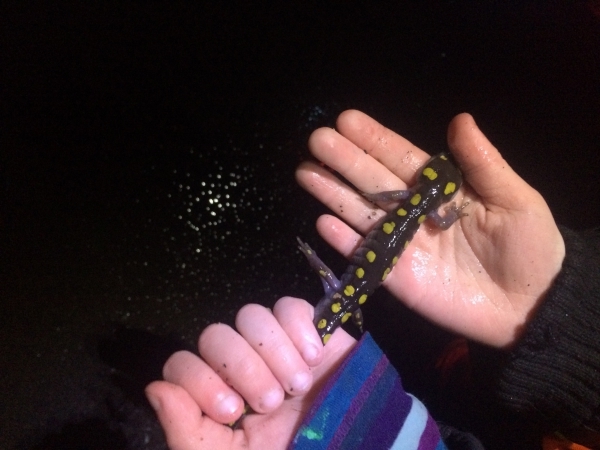BRATTLEBORO — It was a wet, spring evening when my 6-year-old and I set out to help salamanders and frogs cross the road a few miles from our Brattleboro home.
With temperatures hovering in the upper 30s amidst steady rain, it was perfect, early-spring weather for the annual amphibian migration known as “big night,” when adult salamanders and frogs crawl out of their burrowing winter habitat and return to their watery birthplaces to breed.
And because roads often come between their winter habitat and these wetland breeding grounds, “salamander crossing guards” like us are needed to move them safely across the road.
I'd located this amphibian road crossing through a website run by Bonnyvale Environmental Education Center, or BEEC. I'd participated in several crossings during my years as a biology teacher, but this was my daughter's first one, and we were both giddy with excitement.
* * *
Arriving shortly after dusk with headlamps and reflector vests, we were soon joined by nearly 10 other people: the unofficial “site coordinator,” who'd been recording data at this location for years, a local BEEC staffer, and a family spanning three generations.
Amphibians were out in even greater numbers. In just two hours, our group crossed several hundred, including spring peepers, wood frogs, and yellow-spotted and four-toed salamanders.
First, my daughter moistened her hands, as she'd learned at BEEC camp. Then, handling the amphibians with gentle excitement (mostly), she carried them safely to the other side of the road.
She quickly learned to identify each species for our tally: wood frogs were bigger with a dark mask and a quack-like call; peepers were tiny with an “x” on their back and a high-pitched squeak; spotted salamanders, which she lovingly nicknamed “sals,” were longer than her hand with bright yellow dots; and their much-smaller cousins bore the unusual distinction of having four-toed hind feet.
The clear highlight was the wood frog that wriggled up her sleeve to take temporary refuge in her armpit.
* * *
Some crossings result in such high amphibian mortality that culverts or tunnels are built for protection, but we saw only a few cars that evening. So it's possible that most of the amphibians would have fared just fine without us.
But the experience was the closest, most impactful encounter with wildlife my daughter has had so far - and one that I hope will help to foster a lifetime of connecting to the natural world.
